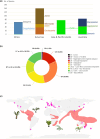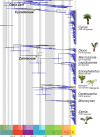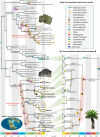Reconciling fossils with phylogenies reveals the origin and macroevolutionary processes explaining the global cycad biodiversity
- PMID: 37302411
- PMCID: PMC10953041
- DOI: 10.1111/nph.19010
Reconciling fossils with phylogenies reveals the origin and macroevolutionary processes explaining the global cycad biodiversity
Abstract
The determinants of biodiversity patterns can be understood using macroevolutionary analyses. The integration of fossils into phylogenies offers a deeper understanding of processes underlying biodiversity patterns in deep time. Cycadales are considered a relict of a once more diverse and globally distributed group but are restricted to low latitudes today. We still know little about their origin and geographic range evolution. Combining molecular data for extant species and leaf morphological data for extant and fossil species, we study the origin of cycad global biodiversity patterns through Bayesian total-evidence dating analyses. We assess the ancestral geographic origin and trace the historical biogeography of cycads with a time-stratified process-based model. Cycads originated in the Carboniferous on the Laurasian landmass and expanded in Gondwana in the Jurassic. Through now-vanished continental connections, Antarctica and Greenland were crucial biogeographic crossroads for cycad biogeography. Vicariance is an essential speciation mode in the deep and recent past. Their latitudinal span increased in the Jurassic and restrained toward subtropical latitudes in the Neogene in line with biogeographic inferences of high-latitude extirpations. We show the benefits of integrating fossils into phylogenies to estimate ancestral areas of origin and to study evolutionary processes explaining the global distribution of present-day relict groups.
Keywords: Antarctica; Cycadales; Greenland; fossil leaves; historical biogeography; total-evidence analysis.
© 2023 The Authors. New Phytologist © 2023 New Phytologist Foundation.
Conflict of interest statement
None declared.
Figures






References
-
- Archangelsky S, Baldoni A. 1972. Notas sobre la flora de la zona de Tico, provincia de Santa Cruz. X. Dos nuevasespecies de Pseudoctenis (Cycadales). Ameghiniana 9: 241–257.
-
- Artabe AE, Stevenson DWM. 1999. Fossil Cycadales of Argentina. The Botanical Review 65: 219–238.
-
- Barnosky AD. 2001. Distinguishing the effects of the Red Queen and Court Jester on Miocene mammal evolution in the northern Rocky Mountains. Journal of Vertebrate Paleontology 21: 172–185.
-
- Barone Lumaga MR, Coiro M, Truernit E, Erdei B, De Luca P. 2015. Epidermal micromorphology in Dioon: did volcanism constrain Dioon evolution? Botanical Journal of the Linnean Society 179: 236–254.
Publication types
MeSH terms
Grants and funding
LinkOut - more resources
Full Text Sources
Miscellaneous

